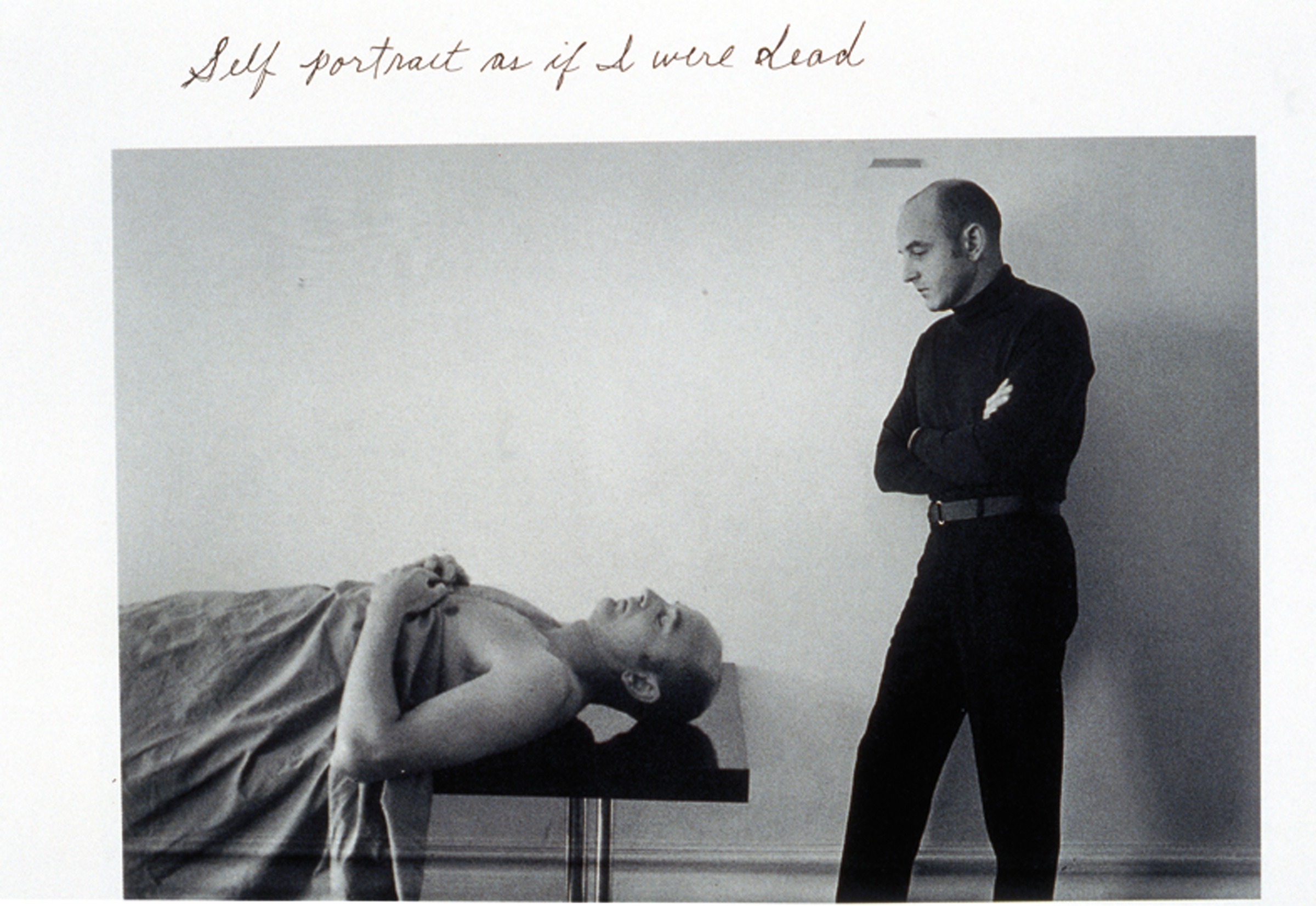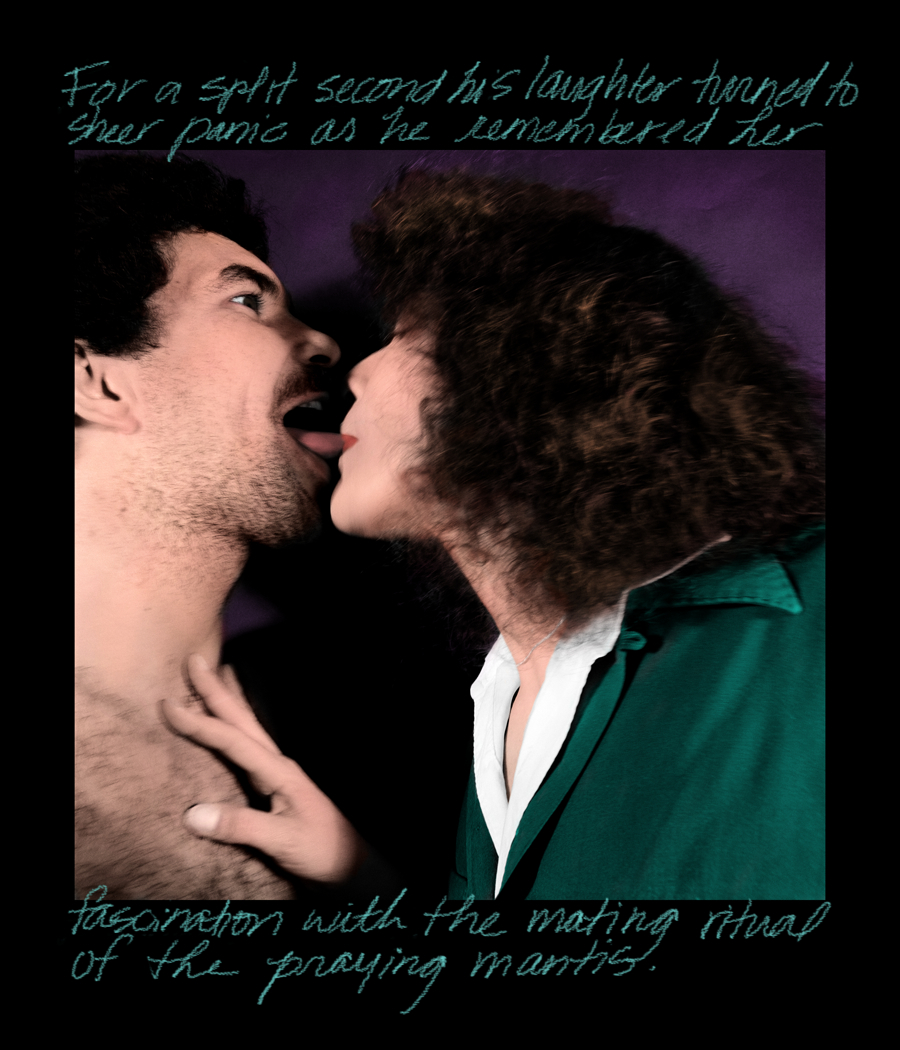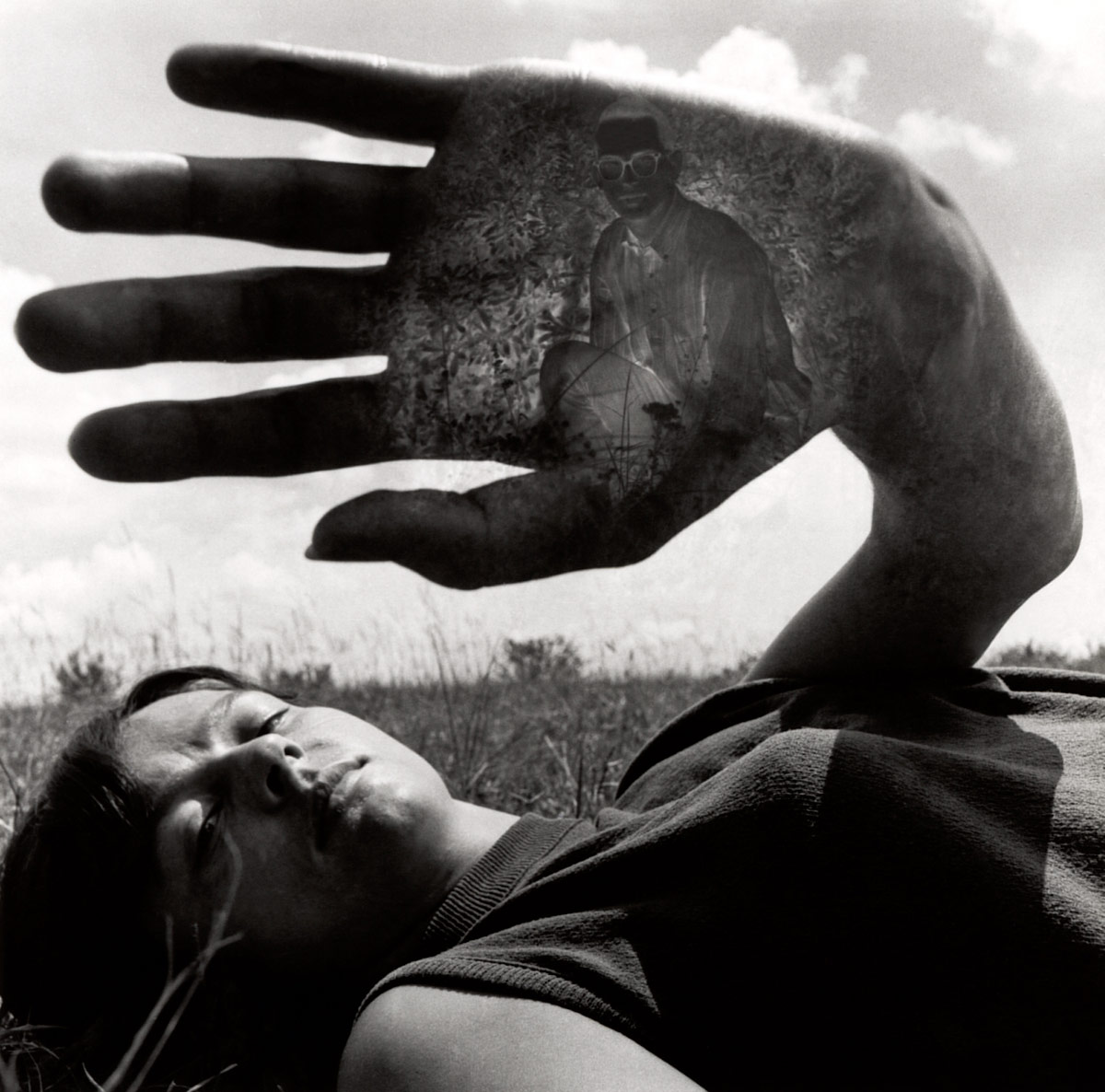Cinematic Staging (1980)
Father, forgive them, for they know not what they do. Luke 23:34.
F Holland Day - The Seven Last Words, 1898. Collection of the Library of Congress.
It is arguable that F. Holland Day is the first 'cinematic' photographer - yet it is very unlikely Holland saw or heard of the first moving picture on perforated film (Lumière Brothers, 1895 in Lyon, France). And it may not matter if he did or didn't, as the 'cinematic' images created by Holland didn't need perforated film, a projector or even popcorn and a darkened theater. Why? Because his static images convey the emotional impact of a motion picture.
Implied motion and drama within multiple frames elicits a 'cinematic' response. In Holland's The Last Seven Words, are some of the most emotionally charged moments in history. The crucifixion: 'cinematic photographs' told in seven panels.
With the inventors of photography emanating from France, England, and even Brazil - it is extraordinary an artist from Boston would be the first American to speak of photography as a fine art, and then to use multiple and composite imagery to express his vision. Throw in self portraiture and performance - it makes F Holland Day the first important American artist who also became a photographer. Holland is to 19th century fine art photography what Mathew Brady was to documentary photography and commercial studio photography.
He is the first artist to identify himself as a fine art photographer on American soil, not just to work in narrative story telling through multiple images.
Oscar J Reijlander - The Two Ways of Life, 1857.
The Royal Photographic Society Collection at the National Media Museum, Bradford, United Kingdom.
Continuing with religion, morals, and allegorical message is the work of Oscar J Reijlander, and the most complex composite image pre-1900. Fabricated of thirty images, The Two Ways of Life 1857, was shown at exhibit in England and Scotland, causing such controversy that left side of the image was draped due to the life-like nature of the naked female form and the clarity of cultural message to forego lascivious behavior. The size of the image, at 16x30 inches, added to the reaction from Victorians and their Golden Era morality. (Source: M Pitchard, link.)
Cinematic Vision - Composite or Multiple Image?
Story tellers like F Holland Day, the American, and Oscar J Reijlander, the Swede born in England, held roots in allegorical painting and cathedral-hung, religious triptychs. Remember painting prior to the 19th century salons was not 'art' but instead canons of education, practiced by clergy. It is therefor appropriate that Raphael's 1511 painting, the School of Athens has been compared to The Two Ways of Life. As a painting for the Sistine Chapel, it illustrates the 16th century body of knowledge and teaching its transfer to future generations. Reijlander's teaching is similarly dramatic, and projects the viewer into didactic debate over pious versus sinful choices. Allegorically dramatic, his visual masterpiece implies motion, and narrates through multiple images; it thus fits the definition of 'cinematic photography'.
Yet the simplicity of Reijlander's cinematic message belies the complexity of his technique.
Beyond a single photographic capture, the panoramic form factor of the The Two Ways of Life, envelopes the viewer just as an immersive movie experience today, for example, sitting in an surround (or IMAX) theater. Considering further Rejilander's technique, in the 19th century, multiple images upon a single plate was constrained given the short drying time of Collodion (the prevalent photographic process after 1851) and there was no stop-action lighting. Subject illumination was modulated by skylights or simply by obstruction to open sky - for example a tree creating shade. Exposure time was measured in seconds, thus the cinematic animation of the Two Ways of Life was created through static, expressive pose instead of captured motion.
Just to be clear, figures walking in the allegorical image by Jeff Wall, The Mimic 1982, (far below) could not be captured in the 19th century. Emulsion speed didn't allow it. To create the cinematic illusion of motion, sequenced or composite images were necessary before the invention of dry plates, and sub-second exposure.
Example - multiple images in wetplate Collodion, circa 1880s.
William Morrison was a famed photographer in the theater district of Chicago in the late 1800s, and contemporary to F. Holland Day in working in wetplate Collodion, where handling time was approximately five minutes, before emulsion drying meant failure in processing. Multiple exposures were possible in limited circumstances, such as above - a white gown against a dark background.
William Morrison, Isabelle Coe (portrayed in A Midnight Bell, 1889)

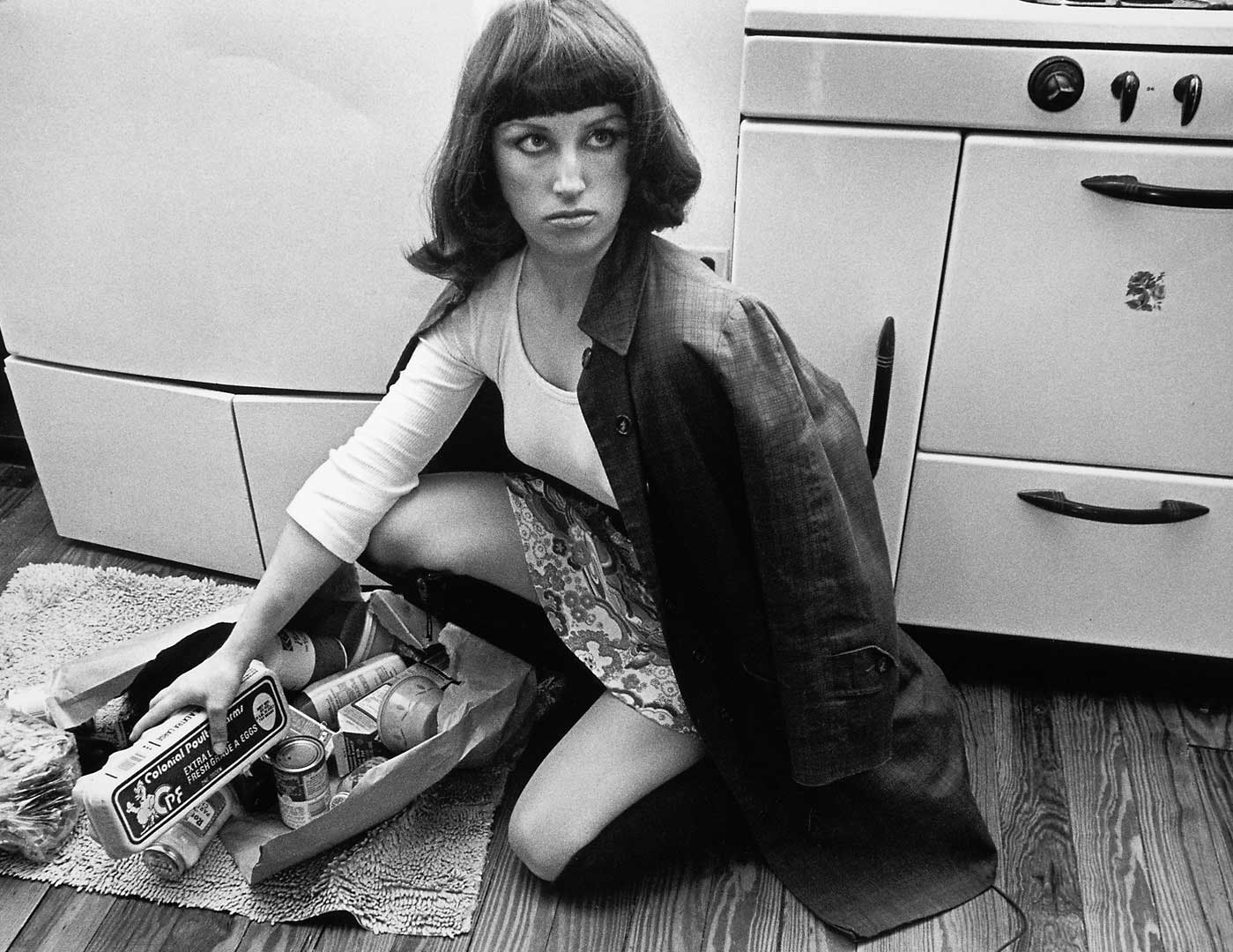

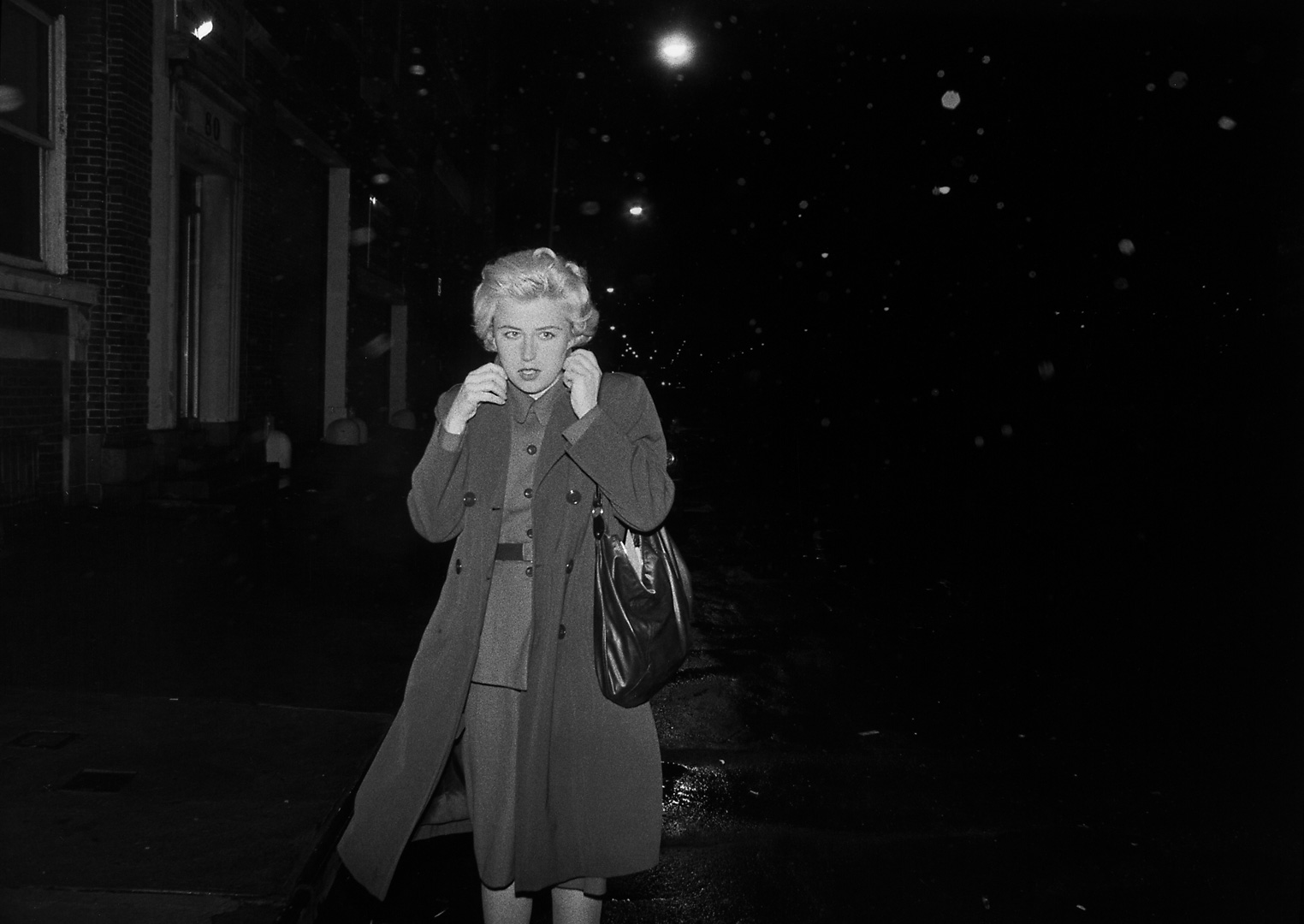
Film Stills 1977 - Cindy Sherman
Subject movement and action are essential to the concepts of cinema and cinematography. The human experience identified with dramatic movement and action - a cinematic moment - also became increasingly paired with publicity stills or movie stills. In addition to multiple or composite photographs evoking cinematic recognition, a single image - a film still - would serve that purpose.
It was the viewer who embellished the larger experience of watching a movie or television - to a single frame.
In Cindy Sherman came one of the first cross-overs from publicity photography to fine art photography, and her work drew international attention from a three year project called Film Stills 1977-1980. Despite careful technique, storytelling and cinematic action within Film Stills, the greatest attention was given to the feminist portrayal of the 'media-stereotyped' female character.
Sherman herself was the lead actor of Film Stills - and the results sliced deep into the mindset of both women and men. The mockery of television, consumer advertising and motion pictures was put on trial for the shallow portrayal cast for women. Vamp, hillbilly, clumsy housewife, seductress - the cavalcade of wooden female characters was in sharp contrast to virulent, heroic silver screen characters like Yul Brenner (The Magnificant Seven) , Stanley Baker (Zulu) or Sean Connery (Dr. No).
The context of Film Stills in the 1980's was coincidentally the period of media deregulation, the rise of cable networks, and the entry of Rupert Murdock's Fox Network (the first to compete with ABC/NBC/CBS since the 1950s). With media proliferation came new opportunity for females within network programming. Sherman's satire of historically shallow female characters, could not have found better contrast than with media's newly rising talent, strong personalities such as Connie Chung, Barbara Walters, and Oprah Whitney.
As described by Eva Respini, former curator of MOMA (and now of ICA Boston): "These Black and White pictures explore the stereotypes of film...that refer to the publicity stills usually shot on set to advertise a film. She's referring to 1950s and 60s film, B movies or European Art House Films, however none of these photographs depict actual films. These are completely fictional moments that are made to look like film stills.... Source: www.MOMOA.org, 2012 Interactive Galleries. (Link)
“I am always surprised at all the things people read into my photos, but it also amuse(s) me. That may be because I have nothing specific in mind when I’m working. My intentions are neither feminist nor political. I try to put double or multiple meanings into my photos, which might give rise to a greater variety of interpretations.”
Regarded as the most successful of late 1970's early 1980's cinematic, fine art photographers, for the next 30+ years Cindy would continue in the genre she gave popular attention to. Perhaps the most surprising attribution to her oeuvre is that Sherman eschews the most obvious connotation - that her work is socially, critically, and overtly disdainful of media stereotypes. She is fine art photography's first well known feminist, but she herself did not wish to attach such meaning to her work.
Untitled Horrors - 2012. Motives found within Cindy Sherman's earliest work continues in current efforts. She has been criticized for becoming a parody of the parody she initially portrayed in Film Stills.
Family and Gender Storyteller - Duane Michals 1970
Sherman was certainly not alone in cinematic style or use of multiple images to tell a story. Four years before her Film Stills project began, Duane Michals published Things Are Queer (1973) followed by Heisenberg's Magic Mirror of Uncertainty and a provocative series on death, The Death Angel. Duane Michals is regarded as one of the most insightful commentators on growing up gay, and on the ambivalence of a father's love vs. social stigmas surrounding homosexuality. His first solo exhibit was at the Museum of Modern Art in 1970, called Sequences.
Duane Michals - A Letter from my Father. 1960–1975, Carnegie Museum of Art
Unlike Sherman, Michals gave whimsical titles to his work and applied hand-written notes to the margins. He was overt in his message, while Sherman initially gave only numbers to each of her images in Film Stills, wanting to minimize forced interpretations. Michals handwritten inscriptions apply scrap booking and publishing connotations (even mail art) to his cinematic genre. (1)
“...I began to write about 20 years ago with photographs, and now I’m writing more and more. I think I can express myself more intimately with language than I can with photographs. So I call myself—when people ask what am I, I say I’m an expressionist. It’s not about photography, it’s not about painting, it’s not about writing—it’s about how well you express yourself in terms of what you have to say, what you need to say.”
Michals had several fast followers, including myself as a narrative photographer in the 1970s. But one of the better known narrative photographers was Barbara DeGenevieve whose fictional stories in single images were marked with pastel chalk on a black background. (2) Similar to Michals, she worked on subjects of human sexuality, gender, trans-sexuality, censorship, and ethics. Contemporary also to Michals was Les Krims, of Buffalo NY, who created fictional narratives in often self-published books with clear corollary to prime time television.
Les Krims created some of the most outlandish narrative productions of the early 1970s, with connotations to crime scene television series such as Dragnet, Colombo, Kojak, Banacek and Canon.
Jeff Wall - Cinematographic Images
While composite imagery had been practiced before 1900, and the darkroom mastery of Jerry Uelsman (3) stood almost without equal in the 1960s and 1970s, influencing the decade of the 1980s was the staged and composited photographs of a Canadian artist named Jeff Wall.
Ten years later, the arrival of Photoshop version 1.0 began to crush of analogue methods into chemical vapor. Everything would start to change. Yet for the period of the late 1970s and early 1980s, Jeff Wall's cinematographic derived compositions would be the new contemporary discourse. Wall, the intellectual, who wrote on art before becoming an artist or a photographer, viewed image making as a tableau for social commentary.
In Mimic 1982, is a curious blend of photographic vernacular (the street photograph) and social commentary on cohesion between races. It is said (Source: Tate.org.uk - Link) Wall was an admirer of the street photography of Robert Frank, yet having chosen a 4x5 camera, the action-capture methods of smaller devices was unavailable to him. Accordingly, he improvised - staging and choreographing his own version of street images in his native Vancouver, British Columbia. But this was no mere transference of film format. Wall took advantage of of the slower more precise process of large format, by staging 'micro-gestures' (slanted view of the Asian pedestrian and gesticulation of the bearded Anglo-Saxon) to draw the viewer in with a rich detail available only upon contemplation and study.
Is it really possible both male characters are using their fingers in racial gesture? Are they mimicking each other? And why is the female companion grimacing? Is it from the sun in her eyes? Or did some remark pass between the parties and result in a hostile, non verbal display?
Jeff Wall's The Mimic 1982 - staged, cinematic, cultural reflection on race and gender.
Jeff Wall's Cinematographic Images, are not all easy to describe nor do they have the same social message as The Mimic. Take for example Overpass 2001 (gallery below), which appears to be a vernacular photograph: accidentally framed, awkward subject focal point, and confusing message. And perhaps there is no message. As Wall himself states:
- "I begin by not photographing." (Interview SOFMA 2007)
- "I'm haunted by the idea that my photography was all a big mistake....Something lingers in me until I have to remake it from memory to capture why it fascinates me." (Interview The Guardian, November 2015.)
Each of these provocative statements have led some to describe Wall as a "non-photographer" in that his approach to photographic creation is entirely atypical. There's no decisive moment, yet his work is carefully orchestrated. And the separation from inspiration to creation has long lags in time. Wall is very much unlike Ansel Adams and the taking of Moonrise over Hernandez (1941), in which the lag from seeing to capture was but a few short minutes. (4)
Thus in describing Wall's work and its sometimes cinematic content, it should be mentioned that in the early 1980's as cable television media exploded and mass advertising reached a zenith (that could only be eclipsed by the addition of Internet advertising), he adopted Airport Billboard back-lit advertising panels as his choice for presentation of large scale images. The glowing Cibacrome transparencies were a clear echo to mainstream media and perhaps even television and motion pictures (each which glow from phosphorescence applied within the tube or applied to the reflective screen).
Below:
- Jeff Wall 1978-2004, exhibition at Tate Museum, London England (showing back-lit advertising panels)
- A View from an Apartment (2004-2005), an image which was months in preparation
- Fieldwork. Excavation of the Floor of a Dwelling (2004) Stó:lō Nation Village, Greenwood Island, Hope, B.C.
- Tattoos and Shadows (2000)
- Overpass (2001)
Multiple, Composite, Narrative, Cinematographic - expanding beyond the Frame
Expansive messages brought photographers beyond the frame of a ground glass or viewing window. Cinematography was developed simultaneously to F. Holland Day's The Seven Last Words, yet in describing his work as 'cimematic" it does not matter if he was aware of the Lumière Brothers - what does matter is his intent to evoke emotion with visual movement possible in multiple frames. Just like Reijlander, who enveloped his audience in the The Two Ways of Life, in one of the largest photographic composite images ever made by 1857, the expansion of frame expanded the impact on the viewer.
Later as commercial film stills were popularized as a substitute for the motion picture itself, Cindy Sherman created cross-over to fine art and applied feminist message. Yet inherent to each of these artists, the medium of the media became integral to the message. As Marshal McLuhan wrote in Understanding Media: The Extensions of Man (1964) - "all media have characteristics that engage the viewer in different ways". Certainly the media explosion in the 1980s advanced the context for Cindy Sherman's Film Stills series, just as it did for Les Krims in The Incredible Case Of The Stack O'Wheat Murders.
It is Jeff Wall who breaks more boundaries than all other cinematic and narrative photographers, combined. In A view from an Apartment, Wall spends months staging a scene which he pre-visualized months earlier - the lag from inspiration to creation is inexplicable to most artists and especially photographers who grew up on a diet of decisive moments. Packaging his images into back-lit frames clearly implies the commercial advertising media he was reacting to, but there is so much more - including the "non-photography" and banal approach to images such as Fieldwork. Excavation of the Floor of a Dwelling.
It is the expression, through mimic of media, use of implied motion and emotive intent - that makes Cinematic Staging the most enlighten discourse in photography surrounding 1980. It fits perfectly into a time when network TV, cable TV and the proliferation of advertising gave visual cues to its context.
-------------------------------------------------------------------------------------------------------------------
Notes:
(1) A technical footnote regarding Duane Michals is he often used an Argus C3 35mm camera for the making of his sequences and multiple images to a single frame of film. The Argus had a film advance mechanism separated from the cocking of the shutter - whereas most cameras of that time combined cocking and advancing to the next frame as a single action - specifically to eliminate the accidental double exposure.
(2) I first met Barbara DeGenevieve during her MFA Studio Show at the University of New Mexico in 1980. Upon graduation she moved to the University of Illinois and then to the Art Institute of Chicago, becoming department chair for Photography. Barbara remained at the Art Institute until succumbing to cervical cancer in 2014. A evocative artist always, she had a studio in the meat market area of Chicago and was acclaimed in later life for the Panhandler Project (2004-2006) in which she paid homeless men to pose nude. She gave each a set of new clothes, $100, meals and a stay in the hotel room in exchange for participating. The image below (right) is indicative of her MFA Studio Show - titled Sheer Panic (date unknown).
(3) The master of composite images - pre-Photoshop release in 1991 - is Jerry Ulesman. Making images now for 50 years, he developed methods of composite photography which can only rival the craft of Reijlander, 100 years earlier. Jerry would setup multiple darkroom enlarging stations and carefully register images, masking with ruby-lith areas of the photograph previously exposed. The results have often been labelled as 'surreal' due to his choice of dreamlike topics. Surrealist artists (1924-1966) where very interested in channeling the unconscious mind to unlock imagination, and Ulesman's imagery, such as Untitled (1966) echo surrealist, psychological messaging. Ulesman's craft as a storyteller falls also in the cinematic narrative style of photography.
(4) Ansel Adams' Moonrise over Hernandez (1941) is one of the most printed (more than 1300 copies were printed by Adams) and reproduced images of American's best well known photographer. The story of making this image depicts rapidly changing light and the act of seeing and capturing.
“We were sailing southward along the highway not far from Espanola when I glanced to the left and saw an extraordinary situation—an inevitable photograph! I almost ditched the car and rushed to set up my 8×10 camera. I was yelling to my companions to bring me things from the car as I struggled to change components on my Cooke Triple-Convertible lens. I had a clear visualization of the image I wanted, but when the Wratten No. 15 (G) filter and the film holder were in place, I could not find my Weston exposure meter! The situation was desperate: the low sun was trailing the edge of the clouds in the west, and shadow would soon dim the white crosses.
I was at a loss with the subject luminance values, and I confess I was thinking about bracketing several exposures, when I suddenly realized that I knew the luminance of the moon—250 c/ft2. Using the Exposure Formula, I placed this luminance on Zone VII; 60 c/ft2 therefore fell on Zone V, and the exposure with the filter factor of 3x was about 1 second at f/32 with ASA 64 film. I had no idea what the value of the foreground was, but I hoped it barely fell within the exposure scale. Not wanting to take chances, I indicated a water-bath development for the negative.
Realizing as I released the shutter that I had an unusual photograph which deserved a duplicate negative, I swiftly reversed the film holder, but as I pulled the darkslide the sunlight passed from the white crosses; I was a few seconds too late!””
Below:
- Argus C3 Camera, favored by Duane Michals
- Barbara DeGenevieve, Sheer Panic (date unknown) - narrative work similar to her MFA Show in 1980 at the University of New Mexico
- Jerry Uelsman, Untitled (1966) - a master of narrative style, often described as surreal due to the dream-like psychological analogies in his work.
- Ansel Adams, Moonrise over Hernandez (1941) - one of his most iconic images.






